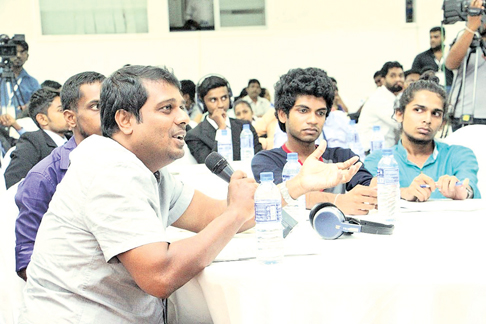|
National Community Video Summit 2016:
'Capturing Local Voices and Strengthening Democracy for Development'
Mainstream media has its own struggle and difficulties in catering
all the segments in a country. As a result of this global reality, we
have excluded communities, voiceless, unheard and underrepresented in
Sri Lanka. Therefore, Sri Lanka needs a strong community video
journalism as an alternative form of media that could cater this
excluded segment, said Mass Media Minister Gayantha Karunathilaka.
He was speaking at the first National Community Video Summit, held
last Sunday at the Sri Lanka Foundation, under the theme 'Capturing
Local Voices and Strengthening Democracy for Development'.
Partnership
The summit was organised by Sri Lanka Development Journalist Forum (SDJF)
to mark its three successful community video training programs
implemented in partnership with Postgraduate Institute of Agriculture,
Prathiba Media Network, Matara, and American Cultural Centre, Kandy.
|

Participants at the event |
The summit brought together more than 200 independent video
journalists including experts from mainstream media, development
agencies, civil society organisations and academia to discuss the
potentiality of Community video as a media to keep citizens informed,
shape their perspectives, facilitate people participation in
democratisation, and help the citizen's to play an active role in
fostering wider justice and accountability.
Nicole A. Chulick, Counsellor, Press, Cultural and Educational
Affairs, Embassy of United States for Sri Lanka and Maldives and High
Commissioner of Canada in Sri Lanka Shelly Whiting also took part in the
event.
Minister Karunathilake noted that community video journalism as an
alternative form of people's media is produced by the community and for
the community. It is used globally to promote conflict resolution, free
expression, social and behavioral change, local knowledge, critical
thinking, democratisation and rural development.
Community video has the potential in bringing local stories on
right-based concerns such as rights of women, children and migrants. It
also helps the community members to reach out to policy makers. It
allows people to participate in media production. In community video
journalism, people are the writers, editors, and producers.
In a traditional media context, the audience is treated as customers,
and consumers. But within community video journalism the audience is
treated as stakeholders and active contributors. This kind of journalism
increases the media literacy of the civil society as well, he said.
Session
The panellist expressed the need of community video journalism to
have recognised by the policy. In chairing a session on community video
- making it a media for people, Dr. Pradeep Weerasinghe noted 'Community
Media, particularly community video journalism needs a welcoming
environment in Sri Lanka, and the Sri Lankan government is committed to
create such an environment. Speaking further he added that mainstream
media must not be seen as the only avenue to disseminate the video's
produced by community video journalists while it's an ideal for the
mainstream media to have a lot allocated for community voices.
Chaminda Karunarathne, Director, News, Swarnavahini noted that
community video journalists should be informed understanding the role of
a journalist in a context where the community he or she lives in crisis.
He also emphasized issues around women, youth, children, and migrants
can also be addressed using community video.
Nicole A. Chulick, indicated that summit sounds a milestone in the
field of video journalism to promote people voice in Sri Lanka.
Dr. Raguram from the University of Jaffna raised a perspective that
giving or talking employment opportunities should be taken as a final
destination of community video journalism. Community video journalism is
something that should survive in the community as an integral part of
it. It should come up in a time of need.
Reality
Prof. W. A. D. P. Wanigasundera, Chairperson of SDJF noted that the
commercialisation, globalisation and politicisation are threats for many
mainstream media. And this is a global reality and not an issue specific
to Sri Lanka alone. Within such a context we also need a media that
could represent all segments of the community regardless of their
diversity, and not treat people as just recipients, particularly women
and children as not just victims.
Such a media should also vividly capture the positives of the
community and culture, build a united identity respecting diversity, and
make people's voice louder.
As a part of the summit Sri Lanka Development Journalist Forum
launched Sri Lanka's first community video newswebsite www.ivoice.lk,
and made it to the audience that community media is not just the voice
of the voiceless. There is no voicelessness but desperate silence. |

